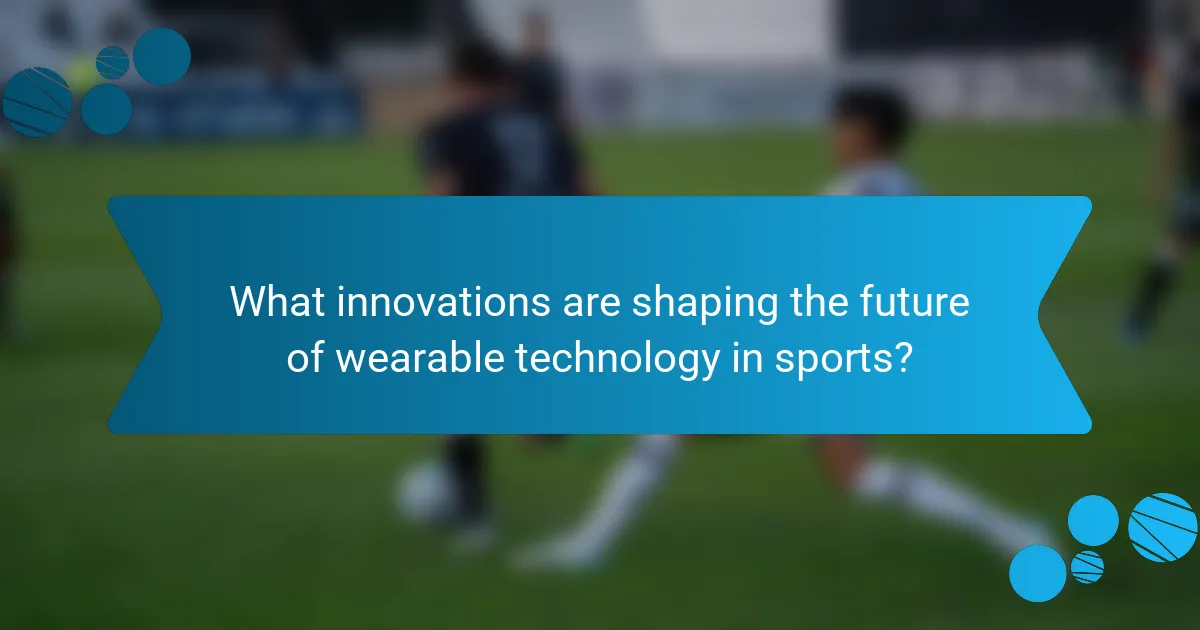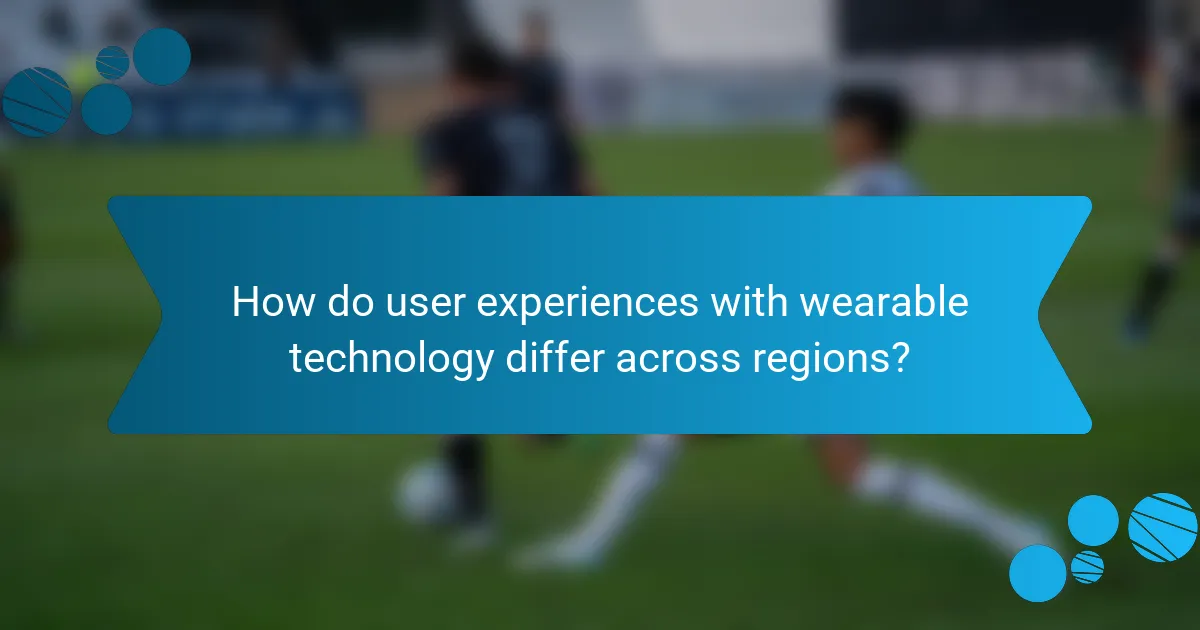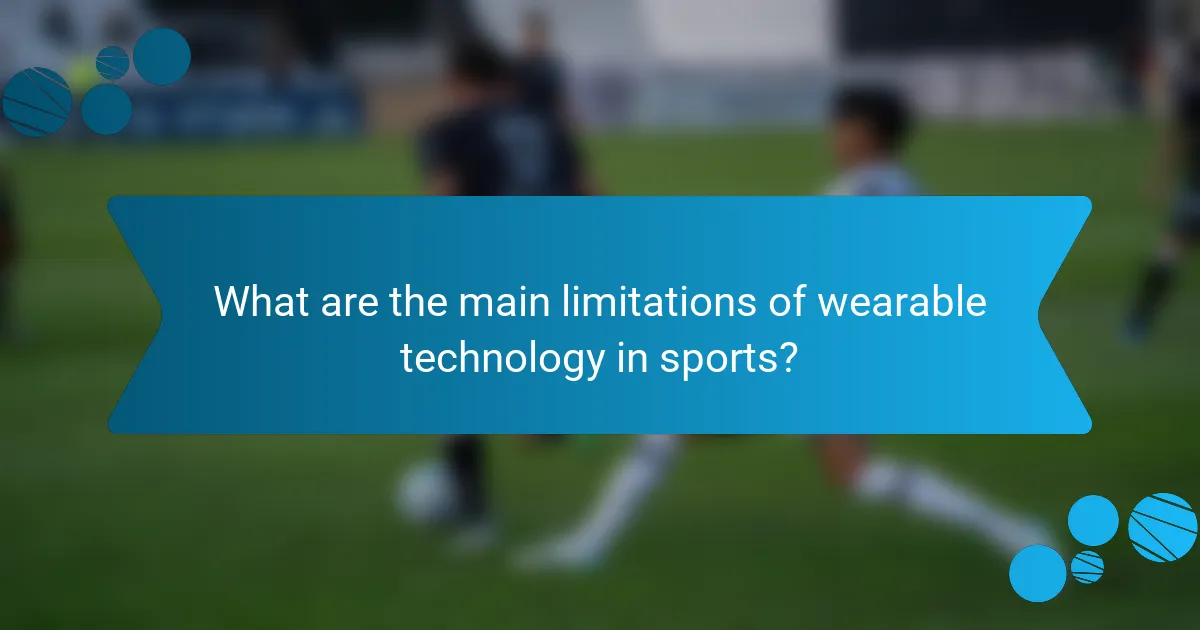Wearable technology in sports enhances performance, safety, and training efficiency. This article explores key benefits like real-time data tracking, innovations such as AI integration and smart fabrics, user experiences across different regions, limitations faced by athletes, and future trends focusing on advanced analytics and immersive training.

What are the key benefits of wearable technology in sports?
Wearable technology in sports offers numerous benefits, enhancing performance, safety, and training efficiency. Key advantages include real-time data tracking, injury prevention, and personalised training insights. These devices monitor metrics like heart rate, distance, and recovery, allowing athletes to optimise their routines. Innovations in wearable tech continuously improve accuracy and user experience, paving the way for future advancements in sports performance.
How does wearable technology enhance athlete performance?
Wearable technology significantly enhances athlete performance by providing real-time data and insights. These devices monitor vital metrics such as heart rate, oxygen levels, and movement patterns, enabling athletes to optimise their training.
Advanced analytics from wearable technology can identify strengths and weaknesses, allowing for personalised training regimens. For example, GPS-enabled wearables track distance and speed, helping athletes refine their strategies.
Additionally, wearables promote injury prevention by monitoring fatigue levels and biomechanical data. This proactive approach allows athletes to adjust their training intensity, reducing the risk of overuse injuries.
Looking ahead, innovations in wearable technology, such as improved sensor accuracy and integration with AI, are expected to further revolutionise athlete performance. These advancements will provide even deeper insights, enhancing training efficiency and competitive edge.
What role does data analytics play in wearable sports technology?
Data analytics significantly enhances wearable sports technology by providing insights into performance and health metrics. It enables athletes to track progress, optimise training, and prevent injuries through data-driven decisions. For instance, real-time analytics can monitor heart rate variability, offering unique insights into recovery and stress levels. As a result, athletes can adjust their training regimens based on precise data, improving overall performance and longevity in their sport.
How can wearables improve injury prevention and recovery?
Wearable technology enhances injury prevention and recovery by providing real-time data and insights. These devices monitor vital signs, movement patterns, and fatigue levels, allowing athletes to adjust their training regimens proactively. For example, smart wearables can detect abnormal biomechanics that may lead to injuries, enabling timely interventions. Additionally, they facilitate recovery by tracking progress and ensuring adherence to rehabilitation protocols. The integration of AI in wearables further personalises recovery plans, optimising outcomes for individual athletes.
Which psychological benefits do athletes gain from using wearables?
Athletes gain several psychological benefits from using wearables, including improved motivation, enhanced focus, and reduced anxiety. These devices provide real-time feedback, fostering a sense of accountability. As a result, athletes can track their performance and set achievable goals, boosting their confidence. Wearables also facilitate better recovery through monitoring stress levels, which can lead to a more positive mindset.

What innovations are shaping the future of wearable technology in sports?
Innovations shaping the future of wearable technology in sports include advanced sensors, AI integration, and enhanced connectivity. These advancements improve performance tracking, injury prevention, and personalised training programmes. For instance, smart fabrics with embedded sensors can monitor biometrics in real time, providing athletes with critical insights. Additionally, augmented reality features in wearables offer immersive training experiences, revolutionising how athletes prepare for competition.
How are smart fabrics transforming athletic wearables?
Smart fabrics are revolutionising athletic wearables by integrating advanced technology into textiles. These fabrics monitor physiological data, enhancing performance and safety for athletes. For example, smart fabrics can track heart rate, body temperature, and hydration levels in real time. As a result, athletes receive immediate feedback, enabling them to optimise their training and recovery. Unique attributes of smart fabrics include their ability to adapt to environmental conditions, providing comfort and support during various activities. This innovation signifies a shift towards more personalised and data-driven athletic gear, paving the way for future advancements in sports technology.
What advancements in sensor technology are influencing sports wearables?
Advancements in sensor technology are significantly enhancing sports wearables. Innovations like miniaturised sensors, improved biometric tracking, and real-time data analytics are driving this evolution. These advancements enable athletes to monitor performance metrics such as heart rate, hydration levels, and muscle strain more accurately. Enhanced connectivity through IoT integration allows for seamless data sharing between devices, facilitating better training insights. As a result, athletes can optimise their performance and recovery strategies.
Which new features are being integrated into wearable devices?
Wearable devices are integrating features like advanced health monitoring, real-time performance analytics, and AI-driven coaching. These innovations enhance user experience and provide deeper insights into athletic performance. For example, new sensors can track hydration levels and recovery metrics, offering unique data points for athletes. Additionally, seamless connectivity with other devices is becoming a standard feature, allowing for comprehensive health tracking and personalised training plans.

How do user experiences with wearable technology differ across regions?
User experiences with wearable technology in sports vary significantly across regions due to cultural, economic, and technological factors. In North America, high engagement with fitness tracking and performance monitoring is common, driven by a strong fitness culture. In contrast, European users often prioritise style and multifunctionality, integrating wearables into daily life beyond sports.
In Asia, rapid technological adoption influences user experiences, with a focus on innovative features and connectivity. Emerging markets may exhibit limited access to advanced wearables, impacting user engagement and experience. Additionally, regional preferences for specific sports can shape the types of wearables used, influencing their functionality and design.
Overall, understanding these regional differences is crucial for manufacturers aiming to tailor wearable technology to diverse user needs and preferences.
What are the common challenges faced by athletes in North America?
Athletes in North America commonly face challenges such as injuries, mental health issues, and performance pressure. Wearable technology helps address these challenges by providing real-time data on physical condition and stress levels. This technology enhances injury prevention through monitoring and improves mental resilience by tracking emotional states. Additionally, the integration of wearable devices fosters better communication between athletes and coaches, facilitating tailored training programmes. As a result, athletes can optimise their performance while mitigating common risks.
How do cultural attitudes towards technology impact usage in Europe?
Cultural attitudes towards technology significantly influence wearable technology usage in sports across Europe. Acceptance varies by country, with northern nations often embracing innovations more readily than southern counterparts.
For instance, Scandinavian countries prioritise health and fitness, leading to higher adoption rates of fitness trackers and smartwatches. In contrast, cultural skepticism in some southern regions may slow integration.
Additionally, European sports organisations increasingly promote wearable tech for performance enhancement and injury prevention, reflecting a growing trend towards data-driven training.
As a result, the future of wearable technology in European sports will likely hinge on overcoming cultural barriers while enhancing user engagement through tailored innovations.
Which specific sports see the highest adoption rates of wearables in different regions?
Wearable technology sees high adoption rates in sports like running, cycling, and fitness training across various regions. In North America, running leads with over 60% of wearables used. In Europe, cycling is prominent, with a 45% adoption rate. In Asia, fitness training dominates, accounting for 50% of wearable usage. The trend reflects regional preferences and the growing focus on health and performance optimisation.

What are the main limitations of wearable technology in sports?
Wearable technology in sports faces several limitations. These include issues with accuracy in data collection, battery life constraints, high costs, limited user adoption, and privacy concerns regarding data security. Additionally, the integration of these devices with existing training protocols can be challenging for athletes and coaches.
How do accuracy and reliability issues affect user trust?
Accuracy and reliability issues can significantly undermine user trust in wearable technology. When data from devices is inconsistent or inaccurate, athletes may question the effectiveness of their training and performance metrics. This skepticism can lead to reduced usage and reliance on the technology. For instance, if a heart rate monitor frequently displays incorrect readings, users may doubt its reliability, impacting their decision-making during workouts. As a result, manufacturers must prioritise high-quality sensors and algorithms to enhance trust and encourage broader adoption of wearable devices in sports.
What privacy concerns are associated with wearable sports devices?
Wearable sports devices raise significant privacy concerns primarily related to data collection and user consent. These devices often track sensitive personal information, including health metrics and location data. Users may not fully understand how their data is used or shared, leading to potential misuse. Additionally, security vulnerabilities can expose personal information to unauthorised access. The unique attribute of these devices is their constant connectivity, which increases the risk of data breaches. As a result, manufacturers must prioritise robust security measures and transparent privacy policies to protect user information.

What future trends should we expect in wearable technology for sports?
Wearable technology in sports will increasingly focus on enhanced data analytics, improved health monitoring, and integration with smart environments. Expect innovations like advanced biometric sensors that provide real-time feedback on athlete performance and recovery. These devices will utilise AI to personalise training regimens and reduce injury risks. Additionally, augmented reality features may transform training experiences by providing immersive simulations. As a result, athletes will benefit from more precise insights, leading to optimised performance and well-being.
How will artificial intelligence influence wearable sports technology?
Artificial intelligence will significantly enhance wearable sports technology by improving data accuracy and personalisation. AI algorithms analyse real-time performance metrics, offering athletes tailored insights for training optimisation. This leads to better decision-making and injury prevention strategies. Furthermore, AI-driven predictive analytics can forecast performance trends and suggest adjustments, enhancing overall athletic performance. The integration of AI into wearables also supports advanced features like biometric monitoring, providing deeper health insights and fostering a proactive approach to athlete well-being.
Which emerging markets are likely to adopt wearable technology in sports?
India, Brazil, and Southeast Asian countries are likely to adopt wearable technology in sports. These emerging markets show increasing interest in health and fitness, driving demand for innovative sports wearables. India’s growing fitness culture and smartphone penetration enhance adoption potential. Brazil’s passion for sports and fitness trends supports market growth. Southeast Asia’s digital transformation and youth engagement in sports further boost opportunities for wearable technology integration.
What role will sustainability play in the development of future wearables?
Sustainability will play a crucial role in future wearable technology by promoting eco-friendly materials and energy-efficient designs. Manufacturers are increasingly focusing on reducing environmental impact while enhancing user experience. Innovations like biodegradable components and solar-powered devices exemplify this trend. As a result, wearables will align with global sustainability goals while meeting consumer demand for responsible products.
What best practices can athletes follow to maximize the benefits of wearables?
Athletes can maximize the benefits of wearables by following best practices that enhance data accuracy and performance. Regularly calibrating devices ensures precise measurements. Setting specific goals helps in tracking progress effectively. Utilizing data analytics allows athletes to interpret metrics for informed decisions. Engaging with coaches to integrate insights fosters a collaborative approach to training. Finally, ensuring devices are comfortable and worn consistently enhances usability and effectiveness.